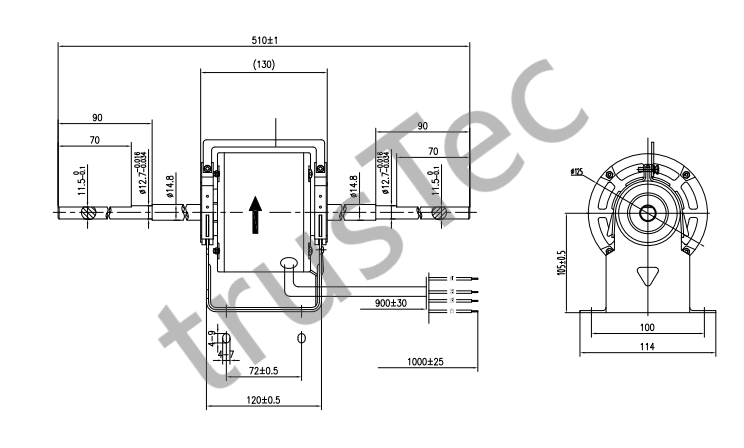Changzhou Trustec Company Limited |
|
Verified Suppliers
|
|
Product Features
●RATED VOLTAGE:220V,50Hz
●POLES:8P
●RATED OUTPUT POWER:160W
●OPERATING TYPE:S1
●INSULATION CLASS:B
●AMBIENT TEMPERATURE:-10~45(℃)
●AMBIENT HUMIDITY:≤RH90%
●ROTATION:CW(LE)
●Speed:1500 RPM
Rated Outline

Key Parameters
| Model | Power /W | Frequency /Hz | Speed /RPM | Current /A | Voltage /V |
| TZD120-160-8 | 160 | 50 | 1500 | 2.0 | 220 |
Ps:all dimension can be customized according to customer requirement.


Product Features
1. Wide speed range, strong overload ability, high reliability, good stability.
2. Excellent torque characteristic, good torque performance in middle & low speed, large starting torque, small starting current.
3. Reasonable structure, high efficiency, low temperature rise, low noise, small vibration.
Product Applications
1. Air conditioning and other ventilation equipment
Main advantages
1. Our top management is born from motor technicians.
2. OEM and ODM offer.
3. UL, CCC, ROHS, CE certificate and strict quality control.
4. We have had more than 10 years export experience, especially to Mid-east and South America.
5. Own a competent and honest sales team, always efficient to all your requirements.
Structure
A brushless DC motor is composed of two main parts: the rotor and the stator
Stator
The stator carries the windings of the motor unlike brushed DC motors; coils are not in the rotor but are wound and fixed to the stator. Wires are wrapped around laminated steel arms or teeth, forming stator windings. Windings can be arranged in two configurations: concentrated and distributed. These two differ in the way the coils are wound around the stator and the waveform of its back-EMF. In a concentrated winding, each phase is wound around a stator arm and gives a trapezoidal back-EMF waveform. As its name suggests, distributed winding has phase coils distributed along multiple arms, giving a sinusoidal back-EMF output. A sinusoidal back-EMF reduces torque ripple but involves extra copper windings.
Rotor
The rotor consists mainly of a shaft and a permanent magnet with alternating magnetic poles. The number of poles in the rotor depends on the application. Having more poles can improve torque but reduce maximum speed. Ferrite magnets are commonly used in the rotor, but rare-earth magnets have significantly taken over this role, especially in electric vehicles because of their greater power density at a much smaller size, offering a lighter and more compact motor design.
Inner rotor design or inrunner
The majority of BLDC motors use the arrangement where the permanent magnet rotor is inside a wound stator. The two main advantages are high heat dissipation efficiency due to the windings’ position, and the ability to minimise the overall girth of the motor unit. However, high energy magnets need to be used and could have an impact on cost. Because of its low inertia, the inrunner design is suitable for highspeed applications, such as fan-jets, RC cars, and electric vehicles.
Outer rotor design or outrunner
In this set-up, the external rotor is housing the stator and is larger than in a conventional motor. This provides a higher moment of inertia and reduces the ripple torque delivering a smooth rotation at low speeds. This design is commonly found in high-torque applications, such as pumps and fans (since the rotor housing can act as a hub).
Advantages of BLDC Motors
A BLDC motor with three coils on the stator will have six electrical wires (two to each coil) extending from these coils. In most implementations three of these wires will be connected internally, with the three remaining wires extending from the motor body (in contrast to the two wires extending from the brushed motor described earlier). Wiring in the BLDC motor case is more complicated than simply connecting the power cell’s positive and negative terminals; we will look more closely at how these motors work in the second session of this series. Below, we conclude by looking at the advantages of by BLDC motors.
One big advantage is efficiency, as these motors can control continuously at maximum rotational force (torque). Brushed motors, in contrast, reach maximum torque at only certain points in the rotation. For a brushed motor to deliver the same torque as a brushless model, it would need to use larger magnets. This is why even small BLDC motors can deliver considerable power.
The second big advantage—related to the first—is controllability. BLDC motors can be controlled, using feedback mechanisms, to delivery precisely the desired torque and rotation speed. Precision control in turn reduces energy consumption and heat generation, and—in cases where motors are battery powered—lengthens the battery life.
BLDC motors also offer high durability and low electric noise generation, thanks to the lack of brushes. With brushed motors, the brushes and commutator wear down as a result of continuous moving contact, and also produce sparks where contact is made. Electrical noise, in particular, is the result of the strong sparks that tend to occur at the areas where the brushes pass over the gaps in the commutator. This is why BLDC motors are often considered preferable in applications where it is important to avoid electrical noise.
Ideal Applications for BLDC Motors
We’ve seen that BLDC motors offer high efficiency and controllability, and that they have a long operating life. So what are they good for? Because of their efficiency and longevity, they are widely used in devices that run continuously. They have long been used in washing machines, air conditioners, and other consumer electronics; and more recently, they are appearing in fans, where their high efficiency has contributed to a significant reduction in power consumption.
They are also being used to drive vacuum machines. In one case, a change in the control program resulted in a large jump in rotational speed—an example of the superlative controllability offered by these motors.
BLDC motors are also being used to spin hard disc drives, where their durability keeps the drives operating dependably over the long term, while their power efficiency contributes to energy reduction in an area where this is becoming increasingly important.